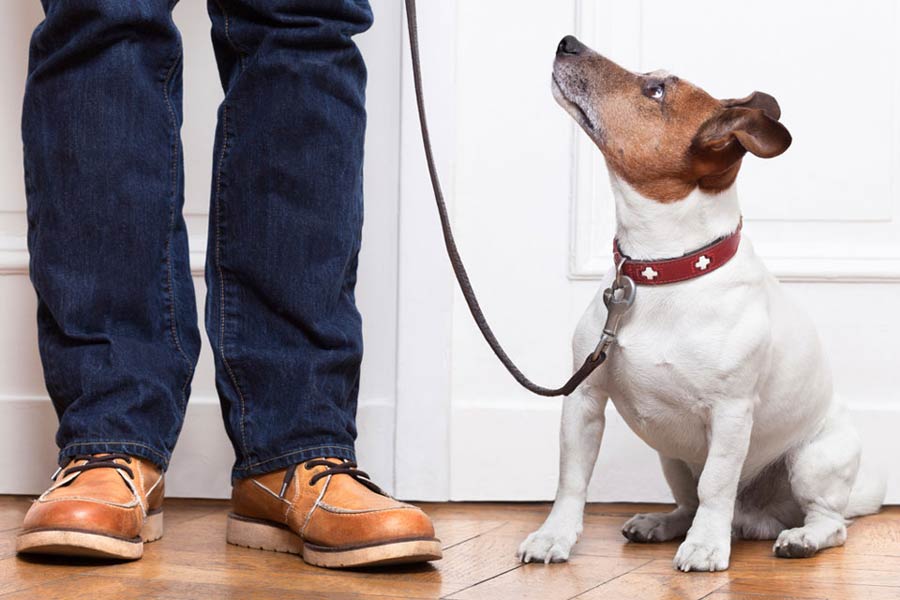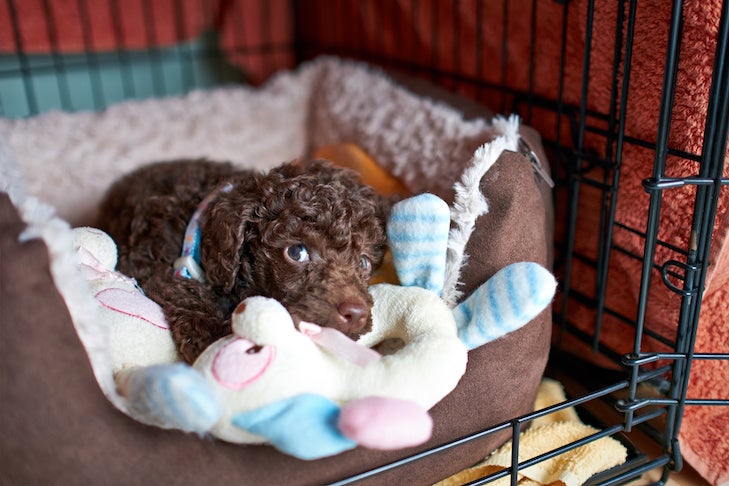AKC GoodDog Helpline is our telephone and video dog training consultation service, offering live, personalized help with your puppy or dog training questions! We’re celebrating GoodDog Helpline’s tenth year in 2023, so we’ve rounded up the most common questions that our dog trainers hear from owners just like you. The first question is, “How do I housetrain my puppy?”
One of the most important first steps for any new puppy owner is potty training. Although dogs don’t like to pee or poop where they eat or sleep, they won’t just automatically know where you want them to “do their business” if you don’t show them. To help prevent your puppy from going to the bathroom in the house, teach them where they should and shouldn’t go. Puppy potty training can be frustrating and confusing, but there are ways to make it easier, both for you and your puppy!
These 10 tips will help you teach your puppy where to potty quicky and efficiently (and with as few accidents as possible), so you can both spend more time learning the fun stuff.
1. Take Your Puppy Outside Every Hour
It should come as no surprise that puppies can’t hold in their pee or poop all day. A good rule of thumb is that puppies can only hold their bladder for a number of hours equal to their age in months, plus one. In other words, if your puppy is four months old, that’s a maximum of five hours (four months, plus one). To help your puppy be successful, and especially with very young puppies or toy breeds, take your puppy out to potty once every hour whenever you can.
This rule of thumb on maximum time between potty breaks applies both during the day and at night, so you’ll be getting up to let your puppy relieve themselves during the night or wee hours of the morning until they’re old enough to hold it overnight.
2. Use a Leash When Taking Your Puppy Outside
Even in a fenced yard, leash your puppy when potty training. During potty breaks, you want your puppy to focus on doing their business, not running around for an impromptu play session (especially at two in the morning). When you take them out, place them on a leash and walk directly to their toilet spot, cue them to “go potty,” and wait for them to go. Visit the same spot every time while you’re potty training, since the scent of previous visits will encourage them to get right to business.

3. Reward Your Puppy for Successful Potty Visits
Whenever your puppy goes pee or poop in the right spot, praise them and offer a favorite treat. That could be a food reward or a play reward – whatever your puppy loves. Because dogs repeat actions that earn them rewards, positively reinforcing good potty behavior will go a long way towards teaching them to use their correct potty spot.
For a late night potty trip, you may want to choose a small, high-value food reward or plenty of verbal praise instead of an energetic game of tug; a wee-hours play session might mean your puppy is now wide awake and ready to rumble when you’d really like for them to settle and go back to sleep. Learn what works best for your puppy, just always be sure to let them know they did a good job when they’ve done what you asked of them.
4. Learn Your Puppy’s Potty Signals
Every puppy has their own set of signals or body language indicating they need to pee or poop. They might sniff the ground, walk in a circle, hunch their back, or start to squat. If you get to know your dog’s personal potty signs, you can predict when they need to go out. As soon as you see the signals, put on that leash and hurry out to the appropriate potty spot, keeping treats or other rewards in your pocket.
5. Keep Your Puppy Crated When You Can’t Supervise
Because dogs don’t like to potty where they sleep, your puppy usually won’t poop or pee inside a properly sized crate unless they’ve been crated longer than they can hold it, or they are sick or suffering from diarrhea. This natural instinct to keep their sleeping space clean makes a crate a perfect potty-training tool. Teach your puppy to love their crate, so they look forward to gnawing on a chew toy or taking a nap inside. Then, when you can’t supervise your puppy, you can keep your potty training on track by giving your puppy some crate time.

6. Don’t Scold Your Puppy for Accidents
There will be times when you take your eyes off your puppy, even just for a moment, or you don’t get them outside as quickly as you should have. And next thing you know, your puppy has had a potty accident in the house. It’s not the end of the world, and accidents happen. What’s important is that you don’t scold or punish your puppy for doing what comes naturally. (And absolutely don’t “rub their nose in it,” which won’t do anything to help teach them what you want.) Your puppy isn’t being “bad” or “vindictive,” and punshing them for a potty accident will only confuse them, scare them, and hurt the bond that you’re working on building with your puppy. It can also end up producing a stealth pooper (or pee-er) who will only go potty when you’re not around because they’ve become frightened. So if you have a potty setback, don’t get angry with your puppy. Instead, just take a moment and revisit your potty training tips to pick right back up where you left off.
7. Clean Accidents Thoroughly
In some scenarios, the scent left behind from pee or poop is helpful because it lets your puppy know that this is the spot where you’d like them to do their business. (That’s part of why the local fire hydrant is such a popular destination to pee on.) But, if your puppy had a potty accident in the house, this scent marker means that it’s important to thoroughly clean the spot to remove all traces of odor, even ones you can’t smell. The best option is to use an enzymatic cleaner that’s specifically designed to eliminate the scent of pet urine, poop, or even vomit, and follow the instructions on the package exactly. Remember, your puppy has a powerful sense of smell that’s far more sensitive than yours will ever be, so if you don’t smell anything, it doesn’t mean your puppy can’t. A specialized pet mess cleaner will remove the scent markers that your human nose can’t detect.

8. Give Your Puppy a Routine
Dogs find routine reassuring, but from a housetraining point of view, giving your puppy a schedule can go a long way toward ensuring success. That doesn’t just mean taking your dog out at the same time every hour. It also means setting a routine for meals, playtime, walks, and naps. Puppies often need to go right after they eat or right after they wake up, and activity makes potty urges happen, too. So, the more you keep a routine for your puppy, the more you can learn to predict the times your puppy will need to go.
9. Don’t Give Your Puppy Unsupervised Freedom in Your Home
It’s essential to always keep your eyes on your puppy. Otherwise, they can sneak off to go potty where you won’t notice, particularly if it’s in a room that they don’t think of as their living space. Every time your puppy goes potty inside the house, they are rewarded by the feeling of relief, and the scent left behind (even after you’ve cleaned it) can encourage them to repeat the behavior. Until your puppy has learned to let you know when they need to go outside to potty, perhaps by barking or sitting at the door, they aren’t ready for unsupervised freedom.
10. Gradually Increase Your Puppy’s Tolerance of Bad Weather
Some dogs can’t get enough of the rain or snow, but many puppies won’t want to go outside to potty when the weather is bad. You can train your puppy to go inside on pads or a litter box for dogs, but if what you really want is for your adult dog to always potty outside, it’s best to teach your puppy to be okay with going outside in any kind of weather. Start with short play sessions, like chase or tug-of-war, outside in the cold or wet weather, and gradually increase the length of time you spend outside as your puppy gets older.
AKC GoodDog! Helpline is celebrating ten years of supporting dog owners. If you need support, experts at AKC GoodDog! Helpline are available by phone or video to answer any training questions that come up, from housetraining your puppy to unwanted behaviors in senior dogs. Join the nearly one million dog owners who trust AKC GoodDog! Helpline today.

